Abstract
The expression of Moloney leukemia virus on the surface of a viral-induced lymphoma cell, availability of the virus to anti-viral antibody, and the nature and extent of activation of the complement system during the cell cycle were studied in vitro. Viral antigen was present on the cell surface, accessible to antibody, and was able to activate complement in the presence of antibody throughout all cellular growth phases, while cytotoxicity was confined to the G1 phase of cell growth. In addition, when cells were arrested in metaphase, viral antigen could be demonstrated on the cell surface by immunofluorescence, and budding virus was seen by electron microscopy. All nine components of complement were activated on the addition of antibody throughout the cell cycle. Additional experiments indicated that in the presence of antibody, C3 and/or C4 were immunospecifically bound to viral-induced lymphoma cells throughout the cell cycle as a result of complement activation. These results indicate that the inability to lyse the cells in the presence of specific anti-viral antibody and complement during the logarithmic phase of cell growth is not due to the lack of expression of Moloney virus antigen(s) on the cell surface, inaccessibility of this surface antigen(s) to antibody, or failure to activate the complement effector system.
Keywords: complement components, cytotoxicity, gammaglobulin, Fischer rats, rabbit
Full text
PDF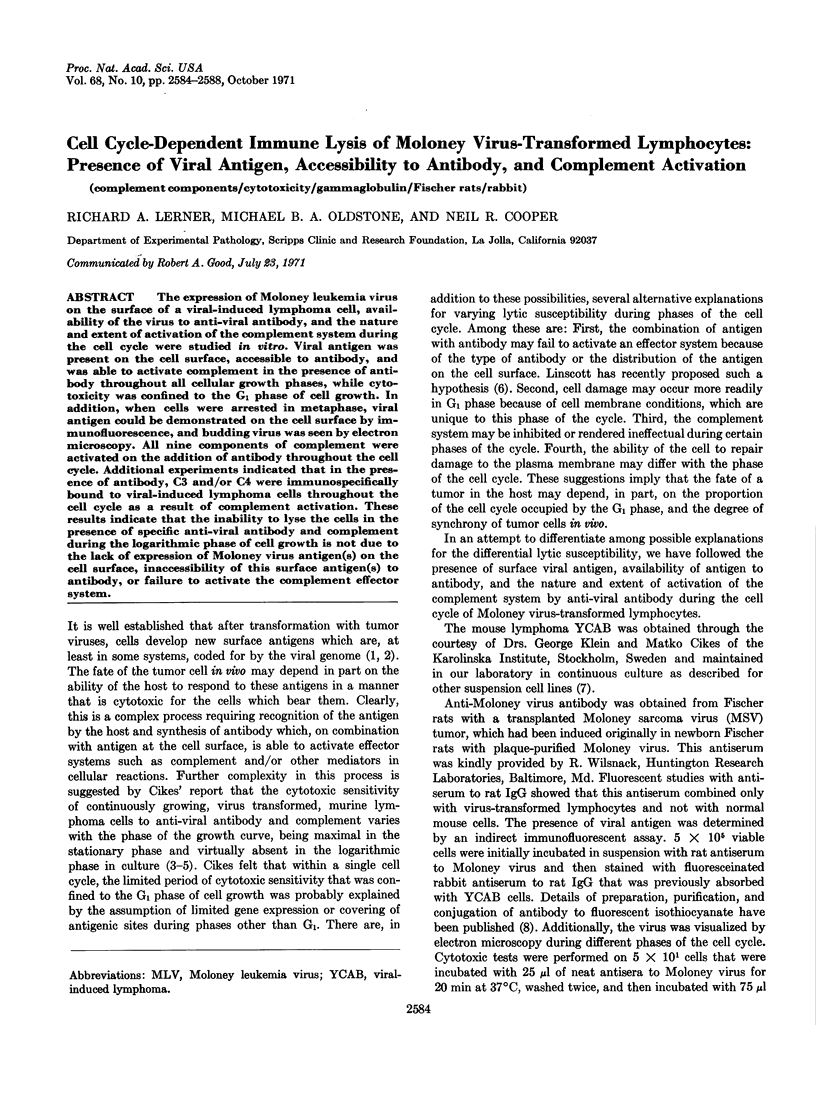
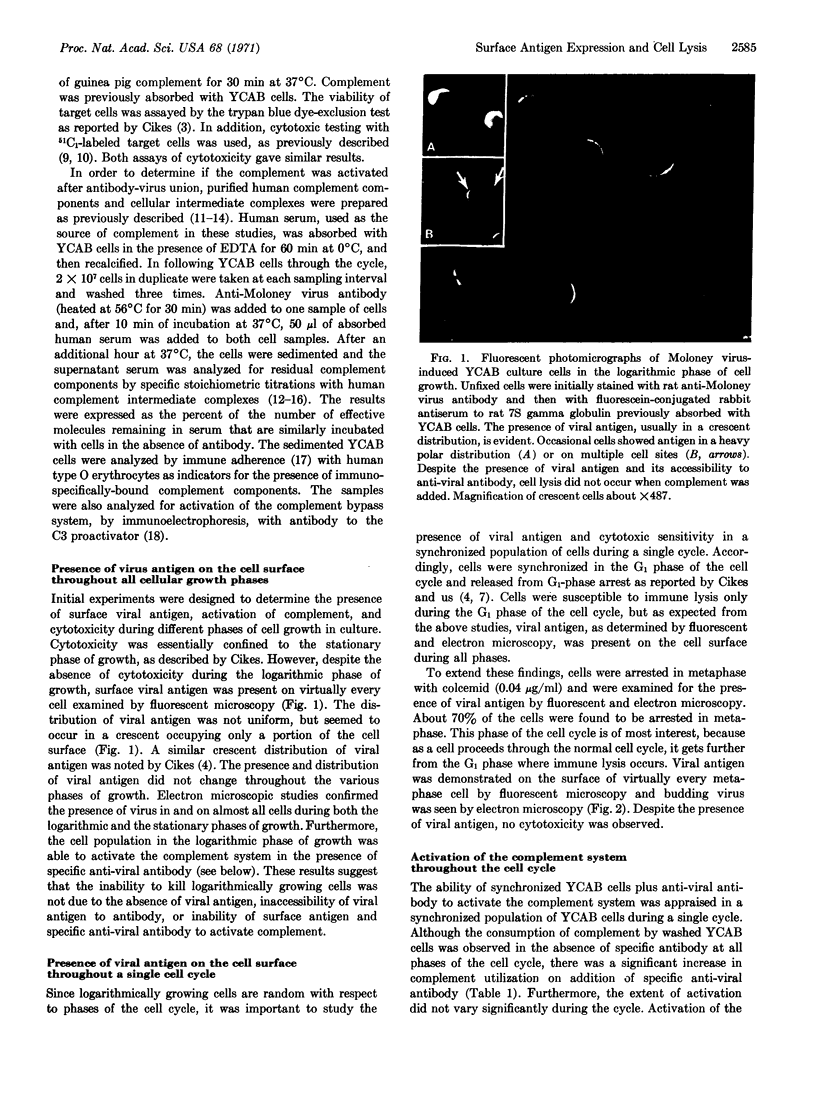
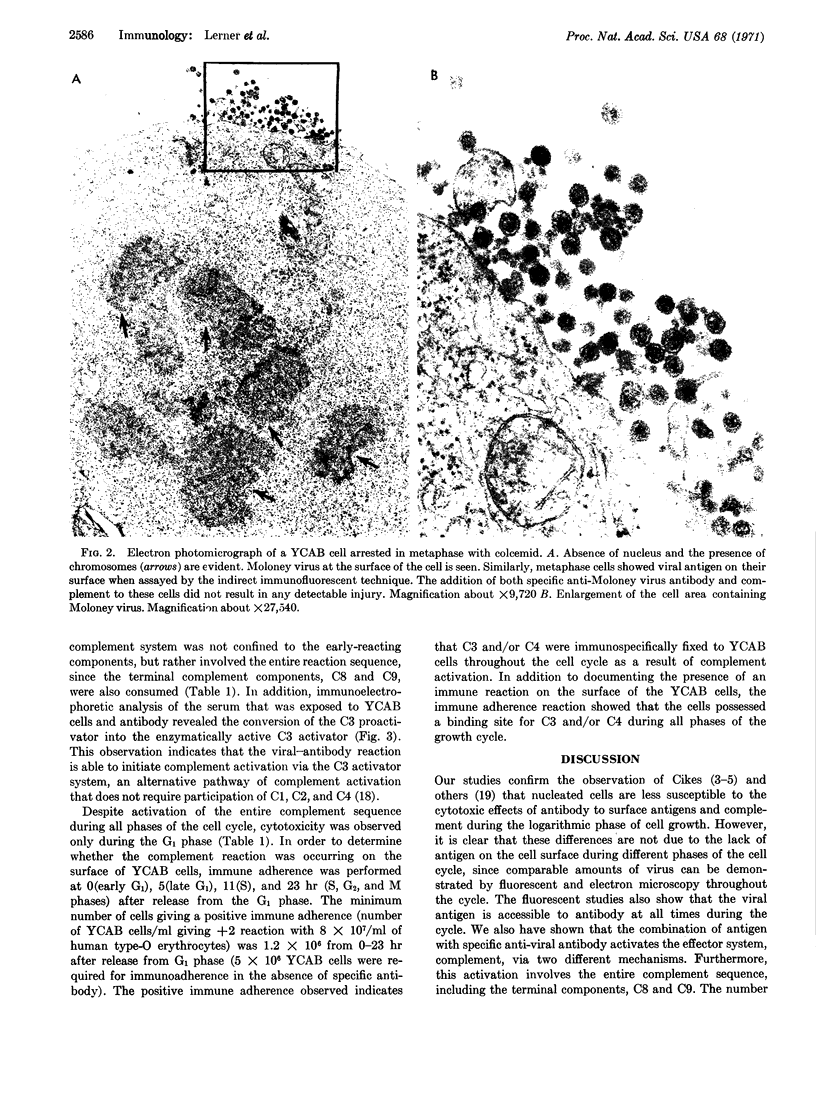
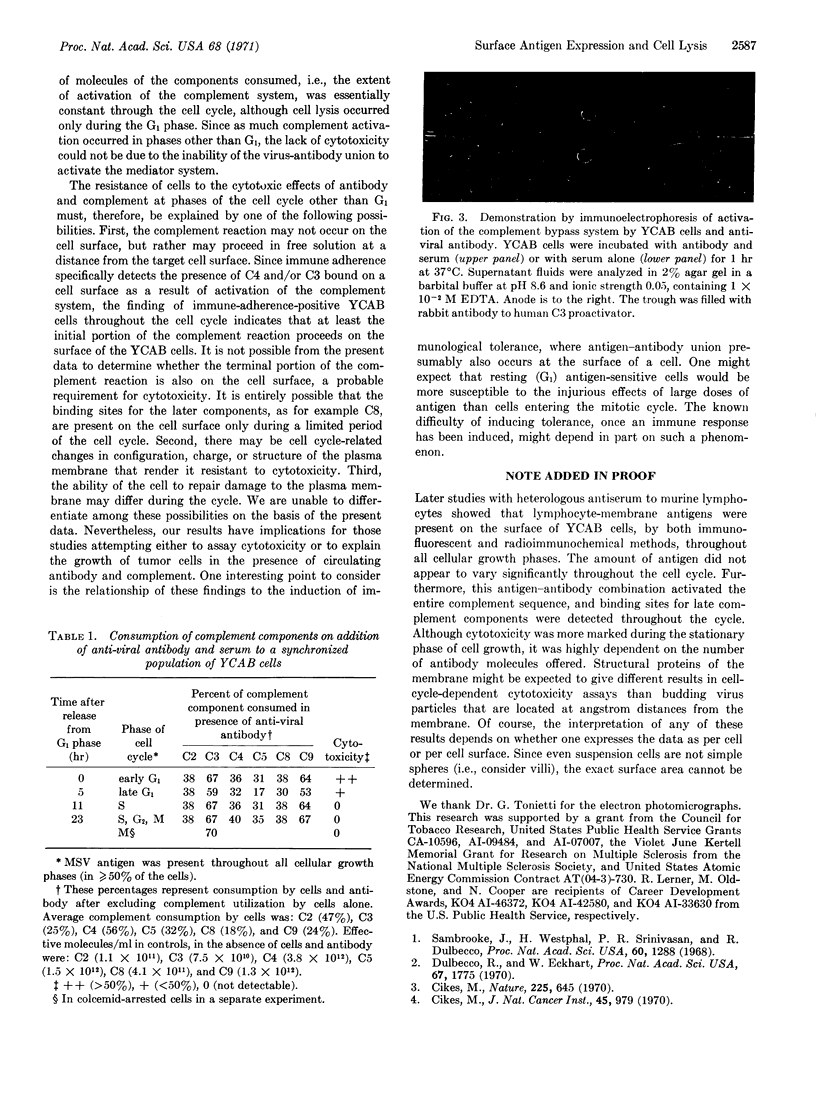
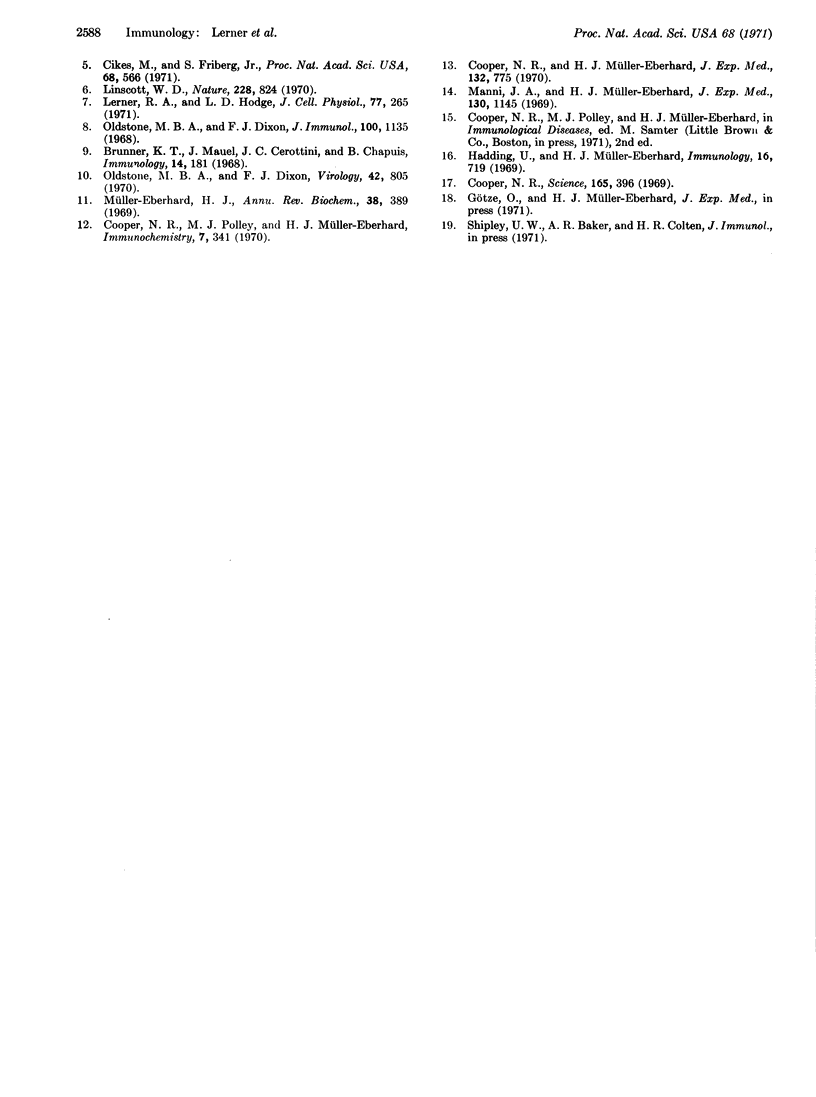
Images in this article
Selected References
These references are in PubMed. This may not be the complete list of references from this article.
- Brunner K. T., Mauel J., Cerottini J. C., Chapuis B. Quantitative assay of the lytic action of immune lymphoid cells on 51-Cr-labelled allogeneic target cells in vitro; inhibition by isoantibody and by drugs. Immunology. 1968 Feb;14(2):181–196. [PMC free article] [PubMed] [Google Scholar]
- Cikes M. Antigenic expression of a murine lymphoma during growth in vitro. Nature. 1970 Feb 14;225(5233):645–647. doi: 10.1038/225645a0. [DOI] [PubMed] [Google Scholar]
- Cikes M., Friberg S., Jr Expression of H-2 and Moloney leukemia virus-determined cell-surface antigens in synchronized cultures of a mouse cell line. Proc Natl Acad Sci U S A. 1971 Mar;68(3):566–569. doi: 10.1073/pnas.68.3.566. [DOI] [PMC free article] [PubMed] [Google Scholar]
- Cooper N. R. Immune adherence by the fourth component of complement. Science. 1969 Jul 25;165(3891):396–398. doi: 10.1126/science.165.3891.396. [DOI] [PubMed] [Google Scholar]
- Cooper N. R., Müller-Eberhard H. J. The reaction mechanism of human C5 in immune hemolysis. J Exp Med. 1970 Oct 1;132(4):775–793. doi: 10.1084/jem.132.4.775. [DOI] [PMC free article] [PubMed] [Google Scholar]
- Cooper N. R., Polley M. J., Müller-Eberhard H. J. The second component of human complement (C2): quantitative molecular analysis of its reactions in immune hemolysis. Immunochemistry. 1970 Apr;7(4):341–356. doi: 10.1016/0019-2791(70)90237-5. [DOI] [PubMed] [Google Scholar]
- Dulbecco R., Eckhart W. Temperature-dependent properties of cells transformed by a thermosensitive mutant of polyoma virus. Proc Natl Acad Sci U S A. 1970 Dec;67(4):1775–1781. doi: 10.1073/pnas.67.4.1775. [DOI] [PMC free article] [PubMed] [Google Scholar]
- Hadding U., Müller-Eberhard H. J. The ninth component of human complement: isolation, description and mode of action. Immunology. 1969 Jun;16(6):719–735. [PMC free article] [PubMed] [Google Scholar]
- Lerner R. A., Hodge L. D. Gene expression in synchronized lymphocytes: studies on the control of synthesis of immunoglobulin polypeptides. J Cell Physiol. 1971 Apr;77(2):265–276. doi: 10.1002/jcp.1040770215. [DOI] [PubMed] [Google Scholar]
- Linscott W. D. Effect of cell surface antigen density on immunological enhancement. Nature. 1970 Nov 28;228(5274):824–827. doi: 10.1038/228824a0. [DOI] [PubMed] [Google Scholar]
- Manni J. A., Müller-Eberhard H. J. The eighth component of human complement (C8): isolation, characterization, and hemolytic efficiency. J Exp Med. 1969 Nov 1;130(5):1145–1160. doi: 10.1084/jem.130.5.1145. [DOI] [PMC free article] [PubMed] [Google Scholar]
- Müller-Eberhard H. J. Complement. Annu Rev Biochem. 1969;38:389–414. doi: 10.1146/annurev.bi.38.070169.002133. [DOI] [PubMed] [Google Scholar]
- Oldstone M. B., Dixon F. J. Direct immunofluorescent tissue culture assay for lymphocytic choriomeningitis virus. J Immunol. 1968 May;100(5):1135–1138. [PubMed] [Google Scholar]
- Oldstone M. B., Dixon F. J. Tissue injury in lymphocytic choriomeningitis viral infection: virus-induced immunologically specific release of a cytotoxic factor from immune lymphoid cells. Virology. 1970 Dec;42(4):805–813. doi: 10.1016/0042-6822(70)90330-2. [DOI] [PubMed] [Google Scholar]
- Sambrook J., Westphal H., Srinivasan P. R., Dulbecco R. The integrated state of viral DNA in SV40-transformed cells. Proc Natl Acad Sci U S A. 1968 Aug;60(4):1288–1295. doi: 10.1073/pnas.60.4.1288. [DOI] [PMC free article] [PubMed] [Google Scholar]





